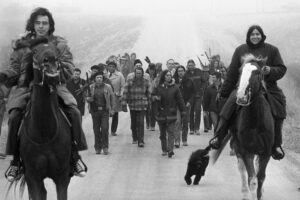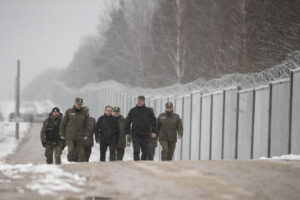Independent Analyst Concludes Environmental Assessment of DAPL ‘Understates the Risk’
Last week, hundreds of water protectors were arrested after a clash with police. In the days since, waves of demonstrations have broken out in support of the #NoDAPL movement.11:15 a.m. PDT Friday, Nov. 4:
The environmental impact of the Dakota Access pipeline has been deemed “insufficient” by an independent reviewer. Common Dreams reports:
The review, commissioned by the tribe, found that the Army Corps’ EA “understates the risk of pipeline failure and related oil release from this pipeline impacting Lake Oahe and the Missouri River,” determined Richard Kuprewicz, a pipeline engineer with the consulting firm Accufacts, Inc.
Earthjustice, which is representing the Standing Rock Sioux in its litigation against the Corps, outlined additional “areas of deficiency” identified in the review:
1. Shoddy pipeline construction
2. The risks posed by landslides were underestimated
3. Lack of proper safety constructions to contain spills
4. Failure to review impact to residents and environment downstream of the site
5. A risk review of industry spills and containment at similar sites that document problematic regulatory oversight of the industry in North Dakota
Read the entire analysis, conducted by Accufacts, Inc., here.
Joining the list of allies in the #NoDAPL movement is The New York Times’ editorial board, which published a piece Thursday titled “Time to Move the Standing Rock Pipeline.“
“The Dakota and Lakota of the Standing Rock tribe would hardly be the first American Indians to pay the price for white people who want to move environmental hazards out of sight, out of mind and out of their water faucets,” it writes. “If the federal government shifts the pipeline route again — perhaps closer to Bismarck — maybe that will prompt a full, meaningful discussion of the pipeline’s merits, with a fairer assessment of its true costs.”
2:24 p.m. PDT Thursday, Nov. 3: After days of peace, protesters and law enforcement once again had a violent confrontation, the newest development in the long-running dispute over the construction of the Dakota Access pipeline.
Protesters, many waist-deep in a creek, faced off against law enforcement officers who were allegedly holding down land that is sacred to the Standing Rock Sioux tribe:
Read more on Wednesday’s intense events here.
1:45 p.m. PDT Thursday, Nov. 3: The support for Dakota Access pipeline “water protectors” is now international. Indigenous Australians joined the Facebook “check-in” solidarity movement over the weekend, Buzzfeed reports:
Over the weekend, Indigenous Australians – including actors, elite sportspeople, politicians, and activists – joined the movement and checked in to the reservation pledging solidarity with Native Americans. …
Aboriginal journalist and Darumbul woman Amy McQuire told BuzzFeed News she checked in because she was “outraged” at the treatment of protesters.
“I was outraged by the treatment of Native American protesters, who are being threatened with arrest, intimidation, and excessive force simply for protecting their sacred country and precious waterways,” McQuire said.
“Their struggle is an international Indigenous struggle, because we are facing similar fights over here – and so I think it’s important we show solidarity in whatever way we can. This is just a small way we can fight against the colonial forces that are still in existence to this day.”
The movement is still spreading across the United States. Earlier this week, demonstrators in New York City shut down Grand Central Station in an effort to raise awareness about the protests. Demonstrators “then marched from Grand Central to the offices of Bank of America and JP Morgan to protest the big banks’ funding of the project,” CNN reports.
***11:06 a.m. PDT Wednesday, Nov. 2:
Those protesting the creation of the Dakota Access pipeline have a new ally: Vermont Sen. Bernie Sanders.
Sanders made his feelings known during a Hillary Clinton campaign rally.
“Stop the Dakota pipeline!” someone in the audience yelled during his speech. “Damn right,” Sanders shot back:
Clinton’s campaign made a more mild response last week after a clash between protesters and police led to more than 140 arrests. “From the beginning of this campaign, Secretary Clinton has been clear that she thinks all voices should be heard and all views considered in federal infrastructure projects,” her campaign’s statement said.
President Obama, who has been notably quiet during the past months of demonstrations, made groundbreaking remarks Tuesday. “I think as a general rule, my view is that there is a way for us to accommodate sacred lands of Native Americans,” he said in an interview with NowThis News. “I think that right now the Army Corps is examining whether there are ways to reroute this pipeline.”
EXCLUSIVE: President Obama on Dakota Access Pipeline protests: “There’s an obligation for authorities to show restraint” pic.twitter.com/UMOklVpldw
— NowThis (@nowthisnews) November 2, 2016
As the political elites are just starting to get involved, activists have quietly raised more than $3 million to resist the construction of the DAPL. Nika Knight of Common Dreams reports:
One crowdsourcing campaign had an initial goal of raising only $5,000, the Associated Press reported Sunday, but topped $1 million. Other fundraising streams have increased the total raised to over $3 million, and the money is going toward legal costs, food, shelter, and other necessities for the camp of hundreds of water protectors near Cannon Ball, North Dakota.
However, the fight is far from over for the “water protecters” demonstrating at the North Dakota encampment. “Members of the North Dakota National Guard have threatened to arrest people on Army Corps of Engineers land who are protesting the Dakota Access Pipeline,” RT says in a new report. “The land should be open to the public — unless the government decides it isn’t.”
—Posted by Emma Niles
***12:45 p.m. PDT Tuesday, Nov. 1:
In the days since last Thursday’s confrontation between the water protectors and North Dakota law enforcement, support for the Standing Rock Sioux has begun to increase.
Over 140 activists were arrested during last week’s clash with police, and those arrested have since alleged harsh forms of mistreatment, such as being forced to stay in dog kennels. A silver lining to the spate of arrests, however, came in the form of an anonymous $2.5 million donation that reportedly was used to bail out all the arrested demonstrators.
As activists flocked to the North Dakota encampment in the hope of joining the Standing Rock Sioux tribe’s peaceful demonstrations, delegations of human rights observers also have descended on the camp. The United Nations “has begun an investigation into the protesters’ claims of human rights abuses,” while Amnesty International “sent a delegation of human rights observers to monitor the response of law enforcement to protests by Indigenous communities in North Dakota.”
Along with this influx of international and domestic support, new details have emerged that shine light on the construction plan of the DAPL. The Bismarck Tribune reports:
An early proposal for the Dakota Access Pipeline called for the project to cross the Missouri River north of Bismarck, but one reason that route was rejected was its potential threat to Bismarck’s water supply, documents show. …
The U.S. Army Corps of Engineers evaluated the Bismarck route and concluded it was not a viable option for many reasons. One reason mentioned in the agency’s environmental assessment is the proximity to wellhead source water protection areas that are avoided to protect municipal water supply wells.
In addition, the Bismarck route would have been 11 miles longer with more road crossings and waterbody and wetland crossings. It also would have been difficult to stay 500 or more feet away from homes, as required by the North Dakota Public Service Commission, the corps states.
The Bismarck route also would have crossed an area considered by federal pipeline regulators as a “high consequence area,” which is an area determined to have the most significant adverse consequences in the event of a pipeline spill.
Since this news broke, demonstrators have argued that it shows inherent racism at the hands of the pipeline planners, as Bismarck has a population that is over 90 percent white.
Reminder that DAPL was re-routed through Standing Rock because Bismarck’s residents feared it could poison their drinking water.
— scare-acotta warrior (@suntzufuntzu) October 29, 2016
The Sioux are literally being forced at gunpoint to accept ecological risks that North Dakota’s white residents refused.
— scare-acotta warrior (@suntzufuntzu) October 29, 2016
The activism certainly has ramped up. Sonali Kolhatkar, a Truthdig columnist, spoke with journalist Rose Aguilar about the demonstrations that continued into last weekend:
Shows of solidarity are spreading across the nation, in cities such as Portland:
Hundreds take to the streets in Portland, Oregon, to protest against the Dakota Access oil pipeline #NoDAPL pic.twitter.com/ZeZJLhR29K
— teleSUR English (@telesurenglish) November 1, 2016
Minneapolis:
Mpls Police Declined to Arrest Sit-In that Condemned @HennepinSheriff Violence Against #NoDAPL Water Protectors https://t.co/IAKp9plBG7 pic.twitter.com/Vy7chvHvAe
— Unicorn Riot (@UR_Ninja) November 1, 2016
#DAPL protesters enter Mpls City Hall and hold large peaceful rally @wcco #standingrock pic.twitter.com/JiqZzdU4Ud
— ColePremoMusic (@ColePremoMusic) October 28, 2016
San Francisco:
“Water is life! Stop the violence!”#NoDAPL activists are protesting outside the San Francisco Department of Justice: pic.twitter.com/et08odGofa
— Fusion (@Fusion) October 28, 2016
Police arrest activists protesting #DakotaAccessPipeline funding at SF Citibank HQ. https://t.co/ZkKn74YfTr #DAPL pic.twitter.com/UUDiVR8MRZ
— NBC Bay Area (@nbcbayarea) October 31, 2016
And on college campuses:
Around 150 people rallied today in Corvallis, Oregon (OSU) supporting water rights & standing in solidarity w/ Standing Rock/#NoDAPL Protest pic.twitter.com/qk0P1qBOh5
— briton ogden (@britonogden) October 23, 2016
Additionally, on Monday night, Bismarck’s State Capitol building was vandalized with motor oil. “You can’t drink oil,” read a sign next to the oil-drenched entrance to the building.
—Posted by Emma Niles
***5:30 p.m. PDT Thursday, Oct. 27:
Democratic presidential nominee Hillary Clinton has finally acknowledged the situation. NBC News received a statement from Clinton campaign spokeswoman Xochitl Hinojosa:
From the beginning of this campaign, Secretary Clinton has been clear that she thinks all voices should be heard and all views considered in federal infrastructure projects,” Spokeswoman Xochitl Hinojosa said in a statement.
“Now, all of the parties involved—including the federal government, the pipeline company and contractors, the state of North Dakota, and the tribes—need to find a path forward that serves the broadest public interest,” Hinojosa said. “As that happens, it’s important that on the ground in North Dakota, everyone respects demonstrators’ rights to protest peacefully, and workers’ rights to do their jobs safely.”
Thursday’s conflict appears to be winding down — although by no means are protesters done standing up to the construction project. The day’s peaceful demonstrations were governed by prayers, even as law enforcement descended upon protesters:
This elder in ceremonial garb held a prayer for everyone gathered on Highway 1806 and was arrested shortly after. #NoDAPL pic.twitter.com/XrL6jqSRFS
— Unicorn Riot (@UR_Ninja) October 27, 2016
Meanwhile, The Guardian provides some insight into today’s hectic events:
The original protest camp – Sacred Stone – is on tribal land owned by Lakota Sioux tribal member Ladonna Allard, on the west bank of the Missouri river, just south of where the smaller Cannonball river flows into it.
As it grew, the camp multiplied and spread. Teepees sprung up along the west bank of the Cannonball – the new camp was formed by Rosebud Sioux – and then up to the county road, and then across the road bridge on to the east bank.
The area on the east bank, where there is much more space, became the main camp once the ranks of protesters swelled in August. That land is owned by the Army Corps of Engineers.
Further east along the road, toward the Missouri river, is the construction site. That’s the place that protesters erected teepees in protest today, and it is that site from which they have been cleared by police.
Finally, an ironically timed news story broke late in the afternoon: Ammon Bundy and six others, who engaged in a militant standoff with law enforcement in a dispute over private property early this year, were acquitted of the charges filed against them. “A federal jury on Thursday found Ammon Bundy, his brother Ryan Bundy and five co-defendants not guilty of conspiring to prevent federal employees from doing their jobs through intimidation, threat or force during the 41-day occupation of the Malheur National Wildlife Refuge,” states Oregon Live. “The jury of nine women and three men returned the verdicts after five hours of deliberations on Thursday in the high-profile case that riveted the state and drew national and international attention to the federal bird sanctuary in rural eastern Oregon.”
Many Dakota Access pipeline demonstrators have drawn comparisons between the treatment they’ve received from police versus how the armed Bundy takeover was handled. Today’s ruling, some say, shows the inherent racist bias behind the treatment of the Standing Rock Sioux tribe and its allies:
All white Bundy militia acquitted after their violent standoff in Oregon. Native protestors at DAPL would never get off-we set dogs on them!
— Cathy Kirk (@cmkirkrn) October 28, 2016
White supremacy–or rather, racist capitalism–explains the differences between the government’s responses to the Oregon standoff & DAPL.
— Bradley Proctor (@bdproctor) October 28, 2016
3:25 p.m. PDT Thursday, Oct. 27:
North Dakota Gov. Jack Dalrymple also appeared on the Morton County Sheriff Department’s Facebook page.
He says all protesters have left the area in question “voluntarily” or “have been arrested.”
“The situation has been well-handled from start to finish,” he added. “Going forward, we’ll finish this operation.”
3:05 p.m. PDT Thursday, Oct. 27: Morton County Sheriff Kyle Kirchmeier answers press questions via Facebook live:
He says the police department has been forced into taking action against the demonstrators. “Starting fire on roadways, camping on private land, disobeying laws of the land and of the county, is not ‘peaceful and prayerful,’ ” he says.
He adds that in addition to the 16 people arrested today, there are “numerous more arrestees” heading to the police station. He also confirms the use of pepper spray on demonstrators.
3:03 p.m. PDT Thursday, Oct. 27: “Our Revolution,” the progressive movement launched by Bernie Sanders, has released statements from board members expressing solidarity with the DAPL protesters.
Neither of the major party presidential candidates has said anything about the current clash between police and protesters.
The Guardian reports that 16 people have been arrested in today’s actions.
2:45 p.m. PDT Thursday, Oct. 27: It seems that the mainstream media has finally begun to weigh in on the DAPL confrontation:
Mark Ruffalo speaks about police violence at pipeline protests in North Dakota: “Very, very aggressive” https://t.co/oj9wDDAphu
— CNN Politics (@CNNPolitics) October 27, 2016
And another Facebook live stream has popped up (live at post time):
2:37 p.m. PDT Thursday, Oct. 27:
Truthdig just wrapped up a live conversation on the pipeline protest with documentary filmmaker and environmental activist Josh Fox.
Meanwhile, tensions between police and protesters are growing. Social media shows what may be the arrest of a tribal elder:
Police have arrested an elder in ceremonial garb who was praying. #NoDAPL pic.twitter.com/IJtXUvPQyd
— Unicorn Riot (@UR_Ninja) October 27, 2016
As well as the use of tear gas:
OurRevolution2: RT wesenzinna: Teargas #DAPL pic.twitter.com/1y8yWFJDzB
— Pasco Revolution (@PascoRevolution) October 27, 2016
There are also reports of pepper spray being used on the crowd.
12:40 p.m. PDT Thursday, Oct. 27: The protesters aren’t the only ones who are social media-savvy: the Morton County Sheriff’s Department is posting updates to its Facebook page. “Protesters have set a bridge on County Road 134 on fire,” it stated about an hour ago. The account has also posted aerial photos:
12:31 p.m. PDT Thursday, Oct. 27:
Tensions appear to be escalating:
— Caroline Grueskin (@cgrueskin) October 27, 2016
that the “operation that commenced at midday involves dozens of officers in riot gear, some of them armed, along with trucks, police cars, military Humvees and buses. At least two helicopters and a fixed-wing airplane monitored the operation from the air.”
However, in a later update, the AP added that many protesters “have retreated from a direct confrontation” but around “200 protesters remain in the area, listening to elders speak, burning sage and praying while law officers approach the camp from two directions.”
12:19 p.m. PDT Thursday, Oct. 27: New live streams of the conflict continue to pop up across social media platforms. Here’s another one (live at post time) from Facebook:
12:13 p.m. PDT Thursday, Oct. 27:
The national guard and law enforcement officials from other cities have appeared on the scene, according to a Morton County Sherriff’s office spokesperson. The Guardian reports:
[They] have officers on the scene from “across the state”, and that they have put out a request for assistance from out-of-state police departments.
She also said that there were national guard on the scene, but added that “they are in a support role.”
Asked if any other agencies – local, state, or federal – were currently taking an active role, she declined to comment.
11:43 a.m. PDT Thursday, Oct. 27:
Social media continues to provide updates of the police raid in North Dakota. It appears demonstrators are trying to build a fiery barricade:
— Caroline Grueskin (@cgrueskin) October 27, 2016
Meanwhile, Sheriff Kyle Kirchmeier has released a statement on the unfolding confrontation:
Protesters’ escalated unlawful behavior this weekend by setting up illegal roadblocks, trespassing onto private property and establishing an encampment, has forced law enforcement to respond at this time. As I said yesterday, I visited the protesters roadblock and requested them to remove the barricade and have protesters vacate the private property.
11:40 a.m. PDT Thursday, Oct. 27:
At the same time North Dakota law enforcement tried to shut down DAPL encampments, protesters arrived at one of Hillary Clinton’s campaign headquarters to draw attention to the issue:
Protestors in lobby of @HillaryClinton HQ Now #NoDAPL pic.twitter.com/iw3I1xqEJy
— BK Molly (@brooklyncybele) October 27, 2016
OurRevolution2: RT brooklyncybele: protestors in lobby of HillaryClinton HQ now #NoDAPL #StandWithStandingRock pic.twitter.com/M9dRPyVT96
— Pasco Revolution (@PascoRevolution) October 27, 2016
11:30 a.m. PDT Thursday, Oct. 27:
Another Facebook user shared live stream of the confrontation:
11:17 a.m. PDT Thursday, Oct. 27:
The fight for clean water in the face of a proposed oil pipeline in North Dakota has escalated once again.
Police in riot gear began “taking steps to remove” protesters of the controversial Dakota Access pipeline Thursday. Very little information was available, but numerous social media users provided glimpses into the conflict. One Facebook user went live to share video footage of the unfolding confrontation:
The website Unicorn Riot, which has provided on-the-ground coverage of the DAPL protests for weeks, also put up a live stream, although the connection was weak.
Users on Twitter provided updates as well:
About to rush the camp #DAPL #NoDAPL pic.twitter.com/7PVwZnj5u8
— wes enzinna (@wesenzinna) October 27, 2016
Fire spreading through the straw bales pic.twitter.com/7AzsZM3UKJ
— Caroline Grueskin (@cgrueskin) October 27, 2016
Flaming barricades as armored vehicles advance #NoDAPL pic.twitter.com/hYuOteXYkM
— Unicorn Riot (@UR_Ninja) October 27, 2016
Spoke to @dennisward moments ago. Here are his pics of police moving in on protestors at #standingrock #NoDAPL @APTNNews pic.twitter.com/ttFCYgwm8Q
— Karyn Pugliese (@KarynPugliese) October 27, 2016
Part of the police presence on Highway 1806 right now. “If you do not walk south you will be arrested.” ##DAPL #NoDAPL pic.twitter.com/HbAlfB034v
— wes enzinna (@wesenzinna) October 27, 2016
Truthdig went live Thursday to discuss the protests with documentary filmmaker Josh Fox.
Stay tuned for updates.
—Posted by Emma Niles
Your support matters…Independent journalism is under threat and overshadowed by heavily funded mainstream media.
You can help level the playing field. Become a member.
Your tax-deductible contribution keeps us digging beneath the headlines to give you thought-provoking, investigative reporting and analysis that unearths what's really happening- without compromise.
Give today to support our courageous, independent journalists.





